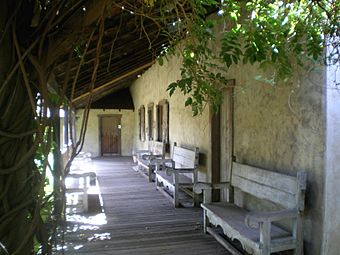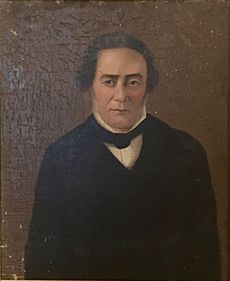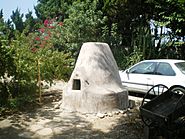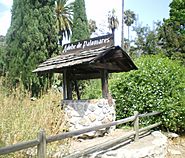Ygnacio Palomares Adobe facts for kids
Quick facts for kids |
|
|
Ygnacio Palomares Adobe
|
|

Ygnacio Palomares Adobe, August 2008
|
|
| Location | 491 East Arrow Highway, Pomona, California |
|---|---|
| Built | 1855 |
| Architectural style | adobe |
| NRHP reference No. | 71000156 |
| Added to NRHP | March 3, 1971 |
The Ygnacio Palomares Adobe, also called Adobe de Palomares, is a historic house in Pomona, California. It was built from 1850 to 1855 for Don Ygnacio Palomares. An adobe is a building made from sun-dried mud bricks.
This special house was left empty in the 1880s and started to fall apart. In the 1930s, the City of Pomona bought it. Then, in 1939, it was carefully fixed up. Since 1940, the adobe has been a museum. It teaches people about what life was like on Spanish and Mexican ranches long ago. The Ygnacio Palomares Adobe was added to the National Register of Historic Places in 1971.
Contents
History of the Adobe House
The Big Rancho San Jose
The Ygnacio Palomares Adobe was built between 1850 and 1855. It was once the main house of a huge ranch called Rancho San Jose. This ranch was about 22,000 acres, which is like 17,000 football fields!
The land for the ranch came from the Mission San Gabriel in 1834. This happened when the Mexican government decided to take control of mission lands. In 1837, the Mexican Governor Juan Bautista Alvarado gave the land to Ygnacio Palomares and Ricardo Vejar. They were both "Californios," meaning they were people of Spanish or Mexican heritage born in California.
The Rancho San Jose covered land where many cities are today. These include Pomona, LaVerne, San Dimas, Diamond Bar, Azusa, Covina, Walnut, Glendora, and Claremont. Don Ygnacio Palomares first lived in an older adobe house called "La Casa Primera".
Building the Adobe Home
Between 1850 and 1855, Palomares built his new home, which is the museum you can visit today. This adobe house had 13 rooms and was shaped like a "T" with a courtyard.
The main living room and master bedroom were at the top part of the "T." The house also had four more bedrooms, a dining room, a kitchen, and storage rooms. There was even a "tienda," which means a small store. The kitchen was near the outdoor oven, called a "horno."
The house shows a mix of Mexican adobe building styles and American ideas. For example, it used wood-shake roofing and wood floors, which were common in American homes.
Life at the Palomares Adobe
The Palomares Adobe was a busy place. It was sometimes used as a stop for stagecoaches traveling between Los Angeles and San Bernardino. The Palomares home was known for being very welcoming. Its doors were open to travelers, and the store provided goods to settlers.
The large living room was used for many years as a meeting place. It was also a chapel where priests from the San Gabriel Mission would come once a month to hold church services. Ygnacio Palomares and his wife raised sheep and cattle on their ranch. They also grew their own crops and raised five children in the adobe house.
The ranch did well for many years. But a very bad drought in the early 1860s caused problems for the ranch. Sadly, three of the Palomares' children died from smallpox. Don Ygnacio Palomares himself passed away in 1864.
Don Ygnacio's wife, Dona Concepcion Lopez de Palomares, started selling parts of the ranch land in 1865. In 1874, another of their children died. Dona Concepcion then sold the last 2,000 acres, including the adobe house. It was sold for $8 an acre to John R. Loop and Alvin R. Meserve.
The Meserve family, the new owners, kept the adobe as a community gathering place. However, by the mid-1880s, the old adobe house was left empty.
The Adobe Falls Apart
From the 1880s to the 1920s, the adobe house was left alone. It started to fall apart badly. Parts of the house washed away, and the walls and roof crumbled. Old photos from 1938 show how damaged the adobe was.
Restoring the Adobe and Making it a Museum
In 1934, the City of Pomona bought the land where the adobe stood. The Historical Society of Pomona Valley then made plans to fix up the adobe. In 1939, seventy workers began the restoration.
They used traditional methods to fix the house. Workers molded new adobe bricks by hand. They used dirt from the Ganesha Hills and straw to hold the bricks together. Then, they dried the bricks in the sun. About 25,000 new adobe bricks were used to restore the house. The cost to fix it was about $54,000. Many of the new bricks were even made from pieces of the old, broken adobe bricks.
The restoration was finished in December 1939. After that, the house was filled with furniture from the time of the California ranches. Mrs. Harry Walker helped lead this effort. The gardens around the adobe were also replanted. They added wisteria vines, wild cherry, black walnut, pomegranate, and poplar trees. Charles Gibbs Adams made sure the new plants were put where they would have been in the 1800s.
The adobe opened to the public in April 1940 as a museum. It teaches about life in early California ranches. At the opening ceremony, the mayor of Pomona gave the keys to the Historical Society. Ygnacio Palomares, the grandson of Don Ygnacio, even danced dances his grandmother taught him!
People loved the restoration. One writer from the Los Angeles Times said it should inspire other communities. He called it "an imperishable glorification of early California." Two years later, the Los Angeles Times said the adobe had become "famous throughout the nation." In 1968, it was called "one of the pleasantest and most complete of the rancho restorations."
Members of the Palomares family were invited to live in the restored adobe as caretakers. Porfiero R. Palomares, who was born in the adobe and was Don Ygnacio's grandson, moved in with his wife and daughter in December 1939. Porfiero lived there until he passed away in October 1942. His wife, Hortensia Yorba Palomares, continued to live in the adobe until she passed away in July 1958.
Mural of the Adobe's Rebuilding (1941)
Artist Frank Stauffacher created a large painting, or mural, in 1941. It shows workers building the Palomares Adobe. This mural is 16.5 feet long and is on a wall at the Pomona Transit Center. The people in the mural are dressed in clothes from the 1800s.
California Historical Landmark
The California Historical Landmark Marker NO. 372 at the site says:
- NO. 372 ADOBE DE PALOMARES - Completed about 1854 and restored in 1939, this was the family home of Don Ygnacio Palomares. Governor Juan B. Alvarado granted Rancho San Jose to Don Ygnacio and Don Ricardo Vejar in 1837.
See also




